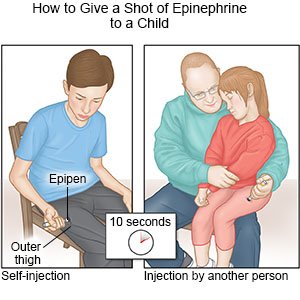Anaphylaxis in Children
Medically reviewed by Drugs.com. Last updated on Aug 4, 2025.
Anaphylaxis is a life-threatening allergic reaction that must be treated immediately. Your child's risk for anaphylaxis increases if he or she has asthma or allergies. Medical conditions such as heart disease can also increase your child's risk. It is important to be prepared if your child is at risk for anaphylaxis. Symptoms can be worse each time he or she is exposed to a trigger.
DISCHARGE INSTRUCTIONS:
Steps to take for signs or symptoms of anaphylaxis:
- Immediately give 1 shot of epinephrine only into the outer thigh muscle. Even if your child's allergic reaction seems mild, it can quickly become anaphylaxis. This may happen even if your child had a mild reaction to the allergen in the past. Each exposure can cause a different reaction. Watch for signs and symptoms of anaphylaxis every time your child is exposed to a trigger. Be ready to give a shot of epinephrine. It is okay to inject epinephrine through clothing. Just be careful to avoid seams, zippers, or other parts that can prevent the needle from entering the skin.

- Leave the shot in place as directed. Your child's healthcare provider may recommend you leave it in place for up to 10 seconds before you remove it. This helps make sure all of the epinephrine is delivered.
- Call your local emergency number and go to the emergency department, even if the shot improved your child's symptoms. Tell your adolescent never to drive himself or herself. Bring the used epinephrine shot to the emergency department.
Call your local emergency number (911 in the US) if:
- Your child has a skin rash, hives, swelling, or itching.
- Your child has trouble breathing, shortness of breath, wheezing, or coughing.
- Your child's throat tightens or his or her lips or tongue swell.
- Your child has trouble swallowing or speaking.
- Your child is dizzy, lightheaded, confused, or feels like he or she is going to faint.
- Your child has nausea, diarrhea, or abdominal cramps, or he or she is vomiting.
Seek care immediately if:
- Signs or symptoms of anaphylaxis return.
Call your child's doctor or specialist if:
- You have questions or concerns about your child's condition or care.
Medicines:
- Epinephrine is used to treat severe allergic reactions such as anaphylaxis. It is given as a shot into the outer thigh muscle.
- Medicines such as antihistamines, steroids, and bronchodilators decrease inflammation, open airways, and make breathing easier.
- Give your child's medicine as directed. Contact your child's healthcare provider if you think the medicine is not working as expected. Tell the provider if your child is allergic to any medicine. Keep a current list of the medicines, vitamins, and herbs your child takes. Include the amounts, and when, how, and why they are taken. Bring the list or the medicines in their containers to follow-up visits. Carry your child's medicine list with you in case of an emergency.
Treatment options
The following list of medications are related to or used in the treatment of this condition.
Safety precautions:
- Keep 2 shots of epinephrine with you at all times. You may need a second shot, because epinephrine only works for about 20 minutes and symptoms may return. Your child's healthcare provider can show you and family members how to give the shot. Check the expiration date every month and replace it before it expires.
- Create an action plan. Your child's provider can help you create a written plan that explains the allergy and an emergency plan to treat a reaction. The plan explains when to give a second epinephrine shot if symptoms return or do not improve after the first. Give copies of the action plan and emergency instructions to family members, work and school staff, and daycare providers. Show them how to give a shot of epinephrine.
- Be careful when you exercise. If you have had exercise-induced anaphylaxis, do not exercise right after you eat. Stop exercising right away if you start to develop any signs or symptoms of anaphylaxis. You may first feel tired, warm, or have itchy skin. Hives, swelling, and severe breathing problems may develop if you continue to exercise.
- Carry medical alert identification. Wear medical alert jewelry or carry a card that explains the allergy. Ask your child's provider where to get these items.
- Identify and avoid known triggers. Read food labels for ingredients. Look for triggers in your environment.
- Ask about treatments to prevent anaphylaxis. You may need allergy shots or other medicines to treat allergies.
Follow up with your child's doctor or specialist as directed:
Allergy testing may find allergies that can trigger anaphylaxis. Write down your questions so you remember to ask them during your visits.
© Copyright Merative 2025 Information is for End User's use only and may not be sold, redistributed or otherwise used for commercial purposes.
The above information is an educational aid only. It is not intended as medical advice for individual conditions or treatments. Talk to your doctor, nurse or pharmacist before following any medical regimen to see if it is safe and effective for you.
Learn more about Anaphylaxis
Treatment options
Symptoms and treatments
Medicine.com guides (external)
Further information
Always consult your healthcare provider to ensure the information displayed on this page applies to your personal circumstances.
